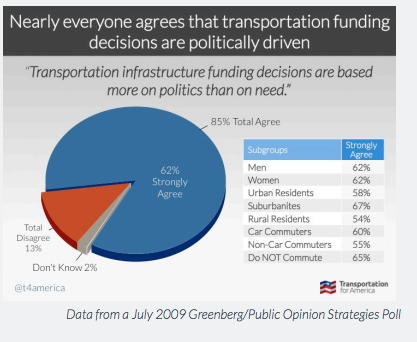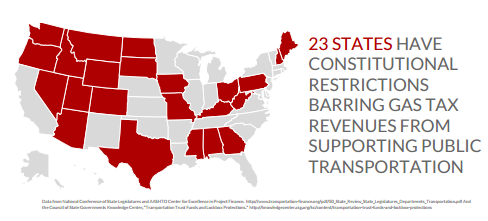
On its page commemorating the 50th anniversary of President Eisenhower signing the Federal Aid Highway Act, the Federal Highway Administration offers a "Then and Now" chart showing how much America has changed since 1956. It's a little corny, but in 1956 Chuck Berry was a chart-topper, hula hoops were the new craze, and Cold War tensions were very high. The point is the country has changed a lot since then.
But not when it comes to transportation policy. Many states are still firmly entrenched in the Eisenhower era, building highways like it's 1956. Are any of them implementing transportation systems for the 21st Century?
There are some forward-looking state transportation policies out there, in fact, and Transportation for America has released a report outlining 12 innovations that may finally make "now" look a lot different than "then" [PDF].
Here are five things that some states are starting to get right:
1. Choose projects based on clearly articulated goals, not political whims
Massachusetts and Virginia have both enacted legislation that mandates public reporting of how state agencies select transportation projects, and how those projects will cost-effectively achieve goals like improved safety, economic development, and better public health.
2. Adopt more flexible street design standards
The National Association of City Transportation Official's Urban Street Design Guide opens up new possibilities for designing streets that work well for walking, biking, and transit. Older engineering guides are more restrictive. So far, 11 states, including Georgia, Tennessee and Utah, have endorsed the guide.
3. Lift bans on spending gas tax revenue on transit, biking, and walking

Nearly half the states -- 23 to be precise -- have constitutional mandates that restrict how gas tax revenue can be spent. Ohio, for instance, won't allow a dime of gas tax revenue to be spent on sidewalks or transit.
In Colorado, the legislature recently rolled back such a restriction, with the backing of city managers, whose constituents are increasingly demanding better transit, biking, and walking.
4. Save money and fix congestion with transportation demand management
Building your way out of congestion is a lost cause. Every expensive new highway lane just invites people to drive more (see: Texas's Katy Freeway).
But states can still tackle congestion with transportation demand management -- incentives that make other options besides solo driving more appealing.
Washington's Commute Trip Reductions program requires employers with more than 100 staff in densely populated areas to use incentives like free transit passes or putting a price on parking. Not only is this far more cost effective than road-building, it prevents the vicious cycle of more highway capacity causing more traffic.
5. Give more money to locals
In the competition for federal transportation funds, states often crowd out the needs of local and regional governments, making it harder for those agencies to deliver things like better transitways or safer streets.
In California, however, 75 percent of capital construction dollars flow to localities. The state still retains a role coordinating land use planning and transportation investments, which can save a lot of money.
Check out the full report [PDF] for seven more recommendations from T4A.





